- Home
- Larry McMurtry
The Colonel and Little Missie Page 2
The Colonel and Little Missie Read online
Page 2
4
IT seems to me that the best way to characterize these two linked but very different human beings—Bill Cody and Annie Oakley—is to start with a brief description of their funerals, which were absolutely in character. Buffalo Bill lost control of his own death, just as he had, by this time, lost control of large patches of his life. He was not even buried until five months after his death, and then wasn’t buried either in the place or in the manner of his choosing.
By contrast Annie Oakley died as precisely as she shot, even going to the trouble to secure a female undertaker to embalm her. As her hour approached she picked out an apricot dress and told the undertaker, Louise Stocker—the only lady undertaker in that part of Ohio—exactly what to do. Louise Stocker did as instructed, though, since Annie had suffered from anemia and was very pale, she did take it upon herself to add a little color to her cheeks.
In our day we have come to expect superstars, particularly female superstars, to behave badly, at least to the help. Martha Stewart and Courtney Love spring to mind. But this was not always so. Both Buffalo Bill and Annie Oakley were deeply loved, not least by their help. Here is a comment by the American artist Dan Muller, whom Bill and Lulu Cody took in as a fatherless boy and helped raise at Scout’s Rest, their big place near North Platte, Nebraska:
Buffalo Bill was one of the world’s great men. I don’t mean wise, but I do mean great. His heart was as big as his show tent, and as warm as a ranchhouse cookstove. Around his supple body there was an aura that people loved to share, whether they were Edward, the King of England, or the lonely tyke of a penniless widow [Muller himself]. We who loved him—we who didn’t depend on his largesse—suffered as weakness gradually caught up with that warm, magnificent man.
And here is Annie Oakley, when she learned of Cody’s death:
I traveled with him for seventeen years. There were thousands of men in the outfit during this time, Comanches, cowboys, Cossacks, Arabs and every kind of person. And the whole time we were one great family loyal to one man. His words were better than most contracts. Personally I never had a contract with the show once I started. It would have been superfluous.
There Little Missie exaggerated a bit. She had contracts, meticulously negotiated by her husband, Frank Butler, and she herself probably read every line of the small print. But the sentiment was true: Cody inspired extraordinary love and loyalty. Even sometimes bitter rivals, such as Gordon Lillie (Pawnee Bill), knowing that Cody had no head for business, tolerated much foolishness while remaining fond. Many were happy to cheat him, and did, but there were more who loved him.
Perhaps Black Elk, the Ogalala sage, who went to England with Cody in 1887, got lost, was found again and sent home by Cody—he recognized how homesick the young man was—said it most simply: “Pawhuska [Cody] had a strong heart.”
Buffalo Bill Cody was outgoing, generous, gushing, in a hurry, incautious, often drunk, and almost always optimistic; in manner Annie Oakley was his polar opposite: she was reserved, modest to the point of requiring a female embalmer, so frugal that many of the troupers believed that she lived off the lemonade that Cody and Salsbury served free to all workers, Quakerish, quiet. But she, like Cody, was a showperson through and through. Even after a bad car wreck, rather late in her life, she once got onstage and danced a jig in her leg brace.
Annie Oakley was also about as competitive as it is possible to be. No sooner had they got to England for Queen Victoria’s Jubilee than a vexing diplomatic problem arose. Grand Duke Michael of Russia, a confident wing shot, proposed a shooting match with Little Missie. Cody and Major Burke, the publicist, were horrified. Of course you mustn’t beat him, they urged. He’s a grand duke!
Nate Salsbury, made of sterner stuff, favored a real contest. Frank Butler kept very quiet—he knew better than to suggest to his wife that she throw a match, any match. In fact, on her first English tour, Annie Oakley was occasionally beaten, but only because she had too heavy a gun or used shot too light for the gusty English shooting conditions. In the contest with Grand Duke Michael she missed three birds out of fifty; the grand duke missed fourteen, but evidently there were no hard feelings and a good time was had by all.
So far as I can determine, Annie Oakley never let anyone beat her. Her first biographer, Courtney Ryley Cooper, put a question to the young Texas sharpshooter Johnny Baker, whom Annie loved, mothering him and helping him in many ways. Although technically a rival, she even helped him improve his act. (She was later to be just as fond of his daughters.)
“Johnny,” I asked, “tell me something. When you used to shoot against Annie Oakley, and she always won, was it because you weren’t trying, or because she was a better shot than you? . . .”
“There was never a day when I didn’t try to beat her,” he said. “But it just couldn’t be done. You know, the ordinary person has nerves. They’ll bob up on him in spite of everything; he’ll notice some little thing that distracts his attention, or get fussed by the way a ball travels through the air. Or a bit of light will get on the sights—or seem to get there, and throw him off. I wasn’t any different from the average person, but Annie was. The minute she picked up a rifle or a shotgun, it seemed that she made a machine of herself—every action went like clockwork. And how was a fellow to beat anybody like that? To tell the truth . . . it would have made a better show if I could have beat her every few performances. But it couldn’t be done.”
When Annie retired, Johnny Baker, who had long been like a son to her, became the principal shooting act for Buffalo Bill’s Wild West.
Annie Oakley cloaked her competitiveness under her modest demeanor, but plenty of people who worked with her knew it was there. She made no secret of her dislike for Lillian Smith, the chubby California teenage sharpshooter whom Cody brought into the show. Technically several of the sharpshooters Annie performed with should have been able to beat her—but they rarely managed to. Like Johnny Baker said, she could become a shooting machine and the others couldn’t.
Competitive or not, Annie Oakley, like William F. Cody, was faithfully and deeply loved, both by her audiences and by her friends. Near the end of her life, when she was at home in Dayton, Ohio, still plagued by her leg brace and suffering from anemia as well, a man who was by then a great superstar himself, Will Rogers, who had been playing Dayton, took notice and paid her a visit. At the time he wrote a daily newspaper column called “The Worst Story I’ve Heard Today,” which ran in more than two hundred newspapers and reached some 35 million readers; soon he would go on to become the highest-paid performer at 20th Century-Fox. Here is his tribute:
This is not the worst story. It is a good story about a little woman that all the older generation remember. She was the reigning sensation of America and Europe during the heyday of Buffalo Bill’s Wild West show. She was their star. Her picture was on more billboards than a modern Gloria Swanson. It was Annie Oakley, the greatest rifle shot the world has ever produced. Nobody took her place. There was only one.
Then—it being an innocent age—he actually gives his 35 million readers Annie Oakley’s address, so her old fans can write to her. Then he adds:
She is a greater character than a rifle shot . . . Annie Oakley’s name, her lovable traits, her thoughtful consideration of others will live as a mark for others to shoot at.
She died on November 3, 1926—the story immediately went out to the world over the AP wire. The story said, among other things, that she was the friend of monarchs and the confidante of her old boss, Buffalo Bill.
Her husband, Frank, ill himself, had gone to Michigan to recuperate. When news reached him of Annie’s death he stopped eating; eighteen days later he died, just in time to be placed in the grave beside her—here’s Shirl Kasper’s report:
. . . on Thanksgiving day, November 25, Annie Oakley made her last trip past the old Public Square where she had sold her quail and rabbits to G. Anthony and Charles Katzenberger so long ago. The old home folks carried her remains up north, past Ansonia
and Versailles and the fields and forests that were so familiar to Annie Oakley. Just south of the village of Brock, they turned off Highway 127 into a little cemetery hemmed in on all sides by fields and trees . . .
Up North Star way, just five miles distant, the rabbits scampered over the field and the quail darted from their covey, just as they had done years before when the girl Annie Moses sat on a moss-covered log with Jacob Moses’s old Kentucky muzzle-loader across her knees. The forests weren’t so thick anymore, but still this quiet farmland was home to Annie Oakley. They buried her under a plain headstone that bore a simple inscription:
Annie Oakley
At Rest
1926
5
IN contrast to Little Missie’s modest burial the big farewell to Buffalo Bill Cody, on top of Lookout Mountain, near Denver, in June of 1917, was, in its way, his final Wild West show. Cody had actually died in January, but could not be buried until June because Lookout Mountain was, after all, a mountain. It could not be reached by motorcade until after the spring thaw, which meant June at the earliest.
Cody himself had planned to be buried on top of Cedar Mountain, near the town of Cody, Wyoming, a community in which he had sunk and lost millions but which he loved—and was loved by—anyway. His last years, like the last years of many showmen, were rich mainly in humiliation. He fell in debt to many people, some of them honorable like Pawnee Bill, but also to others who were merely exploiters, like the Denver newspaper magnate Harry Tammen and his sometime partner Frederick Bonfils, who worked Cody to a frazzle in this show and that circus until the old man was near to dropping. But even in shabby settings that Cody would not have so much as sniffed at in his heyday, he never quite lost his commanding presence. He hated Tammen and sometimes reflected that he ought just to kill him—surely a tempting thought, since Tammen had once sold all Cody’s assets, including his horse Isham, at a sheriff’s sale. Tammen held Cody in contempt, but that didn’t stop him milking the old showman for all he was worth.
When Johnny Baker, performing in New York, heard that Cody was dying he got on the first train but arrived at the bedside of his idol just a little too late. At a few minutes past noon on the tenth of January 1917, Buffalo Bill Cody died. At once the news went out over a special open telegraph line to all the world—and much of the world mourned. President Woodrow Wilson at once sent condolences to Lulu, and the king of England soon followed suit.
Harry Tammen, who had exploited Cody so ruthlessly while he was alive, saw no reason to stop just because the man was dead. Somehow or other, either with bribes or with flattery, Tammen persuaded the grieving widow that burying Cody in a remote village in Wyoming would really be a loss to the nation. Few would journey to distant Cody to see the great man’s grave, but many—indeed millions—might come if the grave was in easy reach of Denver, where, of course, they would be free to do some shopping and perhaps buy a copy of Tammen’s newspaper. One way or another, Lulu was persuaded, and when the snows thawed in June a lengthy procession made its way, with much grinding of gears, up to the rocky grave site.
Gene Fowler, the excellent, too little remembered newspaperman who gave us a fine portrait of John Barrymore in Good Night, Sweet Prince, and a moving one of W. C. Fields in Minutes of the Last Meeting, happened to be working in Denver at the time—for Harry Tammen, in fact. He went to the funeral and left this wonderful report:
Six of the Colonel’s old sweethearts—now obese and sagging with memories—sat on camp chairs by the grave hewed out of granite. The bronze casket lay in the bright western sun. The glass over the Colonel’s handsome face began to steam over after a while, on account of the frosted pane . . . one of the old Camilles rose from her camp chair, with a manner so gracious as to command respect. Then, as if she were utterly alone with her dead, this grand old lady walked to the casket and held her antique but dainty parasol over the glass. She stood there throughout the service, a fantastic, superb figure. It was the gesture of a queen.
One thing Buffalo Bill always had was a robust sense of humor. If he could have been at his own funeral, perhaps sitting by the devoted Johnny Baker, he would, undoubtedly, have laughed long and hard.
6
SOME celebrities—sports heroes particularly—can be seen to earn their fame; they acquire authenticity as they go along, doing what they do. Others just seem to drift into fame, without paying much attention to its arrival. When Buffalo Bill first began to work as an actor in simple Western melodramas, he could rarely remember his lines, few and simple though they were. His friend Wild Bill Hickok was even more tongue-tied; he rarely said anything while onstage. Once in a while Cody and the scout Texas Jack Omohundro might reminisce a bit about some hunt they had been on—when even this commentary dried up, Ned Buntline, who got the two scouts into the acting business, might finish the evening with a temperance lecture. At first the crowds didn’t seem to mind these laconic proceedings—at least they got to look at authentic frontiersmen and, in Hickok’s case, a real gunfighter, whom malchance would soon lead to draw that dead man’s hand in the illegal town of Deadwood—illegal because it was on Sioux land. Aces and eights was the dead man’s hand. Before Hickok was killed he had managed to organize a buffalo hunt near Niagara Falls.
The wind that blew ill for Hickok blew fair for Cody, who did more shows, and yet more shows, until finally he was confident enough to start his own show. But he knew that part of his draw as an actor was that for much of the year he was still a prairie scout—as late as 1876, when he had been on the stage several years, he managed to get back to the West and get into an Indian fight, a famous one, which he was still reprising in his shows until nearly the end of his life. Cody’s clouded record as an Indian killer, rather than as a tracker of Indians, we will look at later—but the fact that he was still often out west where the wild men were added much to his box office appeal. Also, he was very good-looking and he soon mastered certain aspects of showmanship—people were coming to see him in increasing numbers; by the late seventies Bill Cody had a fairly well advanced career on the stage.
Annie Oakley’s stardom was different. Cody had really survived thrilling adventures that could be dramatized and were dramatized. Annie Oakley had mainly her sense of occasion, and her consummate skill with the gun. She did develop an act of sorts, pouting if she missed and giving a charming little back kick if she shot well; but the act was at the service of her shooting. Much later she too appeared on the stage, in a melodrama called The Western Girl, which had a successful run.
In real life she was not a Western girl at all. She loved the cool forests of Ohio, where she had first hunted. Though she traveled west with the show she never actually lived farther west than Cincinnati. The “authentic” part of Annie’s performances was that her bullets almost always hit their targets. She had a long, quiet marriage, and mostly kept to herself while she was performing, though she did like to give tea and cookies to whatever children wandered up. She traveled to Europe more than once and conquered several of the reigning monarchs of the day, of which more later. Her fame did not lessen when she began to limit her performances, mainly to shooting contests. There have been at least eight biographies and a famous musical, Annie Get Your Gun. Many of her biographers eventually find themselves running out of much of anything to say. She shot, she went to her tent, she shook hands with whatever local dignitaries might be assembled; then, the next day, in a different city, she did it again.
Buffalo Bill’s numerous biographers—of which none are recent—have more or less the opposite problem: there was always more to say about Buffalo Bill Cody than could be got between the covers of a single book—though much of it had to be extracted and expanded (or reduced) from a single book, that being the autobiography Cody published in 1879. He probably wrote at least part of it. Sometimes he freely gave chapters of it to other writers on the West. There were many reissues, several plagiarized variants, and for the bibliographer, an unholy mess. Two of his sisters published books abo
ut him and so did Lulu, his much-put-upon wife.
The autobiography itself deals with Cody’s life as a plainsman; it stops a couple of years before his career as a serious impresario begins. It contains many of the set pieces—tropes drawn from Cody’s life—which we’ll look at soon. These tropes are repeated over and over again in the many knockoffs of the autobiography; there are seven or eight at least, some of which awkwardly merge chapters from Cody with newspaper or magazine accounts of his various exploits. These crudely written accounts are tediously repetitive, but they kept appearing, year after year—as did the estimated seventeen hundred dime novels in which he appears.
About a decade after Cody’s death Charles Lindbergh, the Lone Eagle, made his famous flight and became an instant superstar because of it. Lindbergh’s enduring fame resulted from a single act, but Cody’s fame did not develop that quickly, nor did his celebrity really depend on the solid facts of his life. It didn’t depend on his having made the third-longest Pony Express ride in history, or whether he actually killed Tall Bull in 1870 or Yellow Hair in 1876.
Cody’s fame depended, instead, on his truly smashing appearance, which only seemed to get better once his hair began to turn white. He was also a superb horseman. People just seemed to like to watch Buffalo Bill Cody even if all he was doing was riding around an arena waving his hat.
Tim McCoy, the sometime cowboy and star of many silent Westerns, thought Buffalo Bill was the most impressive man he had ever seen; plenty of others thought the same. He couldn’t have moved his Wild West from town to town without good trains, and he couldn’t have become the star he became without the camera. The camera loved him, and it loved Annie Oakley too. They both had the absolute good luck to be photogenic. Cody and Annie were photographed thousands of times. There are many scores of pictures of Buffalo Bill in the midst of his huge troupe—the eye naturally and easily singles him out.

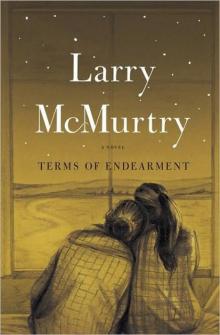 Terms of Endearment
Terms of Endearment Some Can Whistle
Some Can Whistle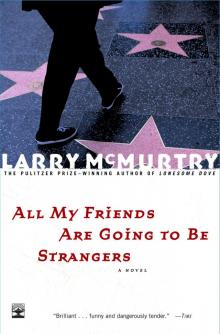 All My Friends Are Going to Be Strangers
All My Friends Are Going to Be Strangers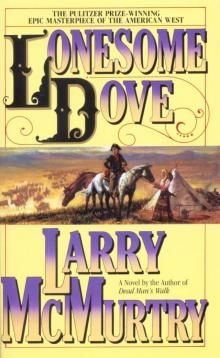 Lonesome Dove
Lonesome Dove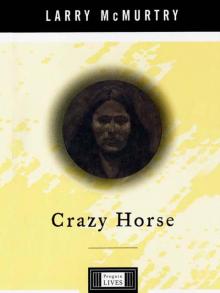 Crazy Horse: A Life
Crazy Horse: A Life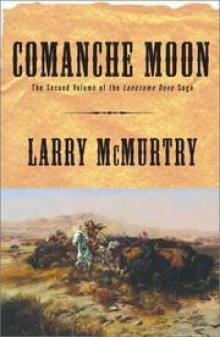 Comanche Moon
Comanche Moon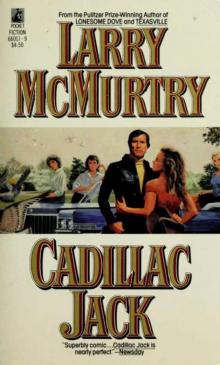 Cadillac Jack
Cadillac Jack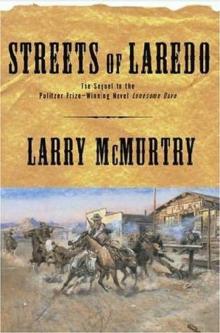 Streets of Laredo
Streets of Laredo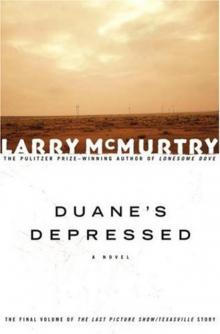 Duane's Depressed
Duane's Depressed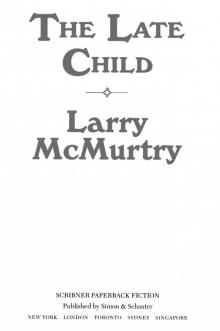 The Late Child
The Late Child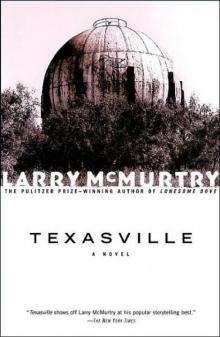 Texasville
Texasville Rhino Ranch
Rhino Ranch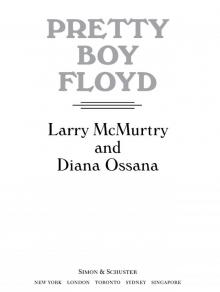 Pretty Boy Floyd
Pretty Boy Floyd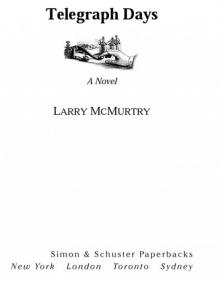 Telegraph Days
Telegraph Days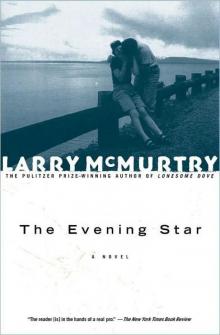 The Evening Star
The Evening Star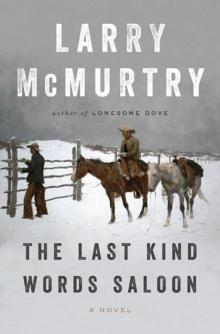 The Last Kind Words Saloon
The Last Kind Words Saloon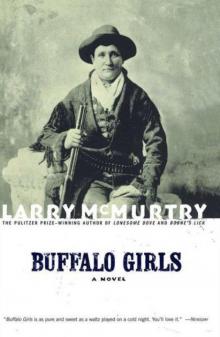 Buffalo Girls
Buffalo Girls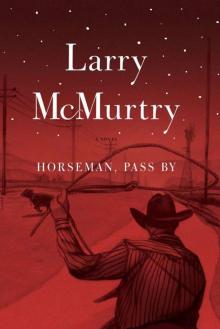 Horseman, Pass By
Horseman, Pass By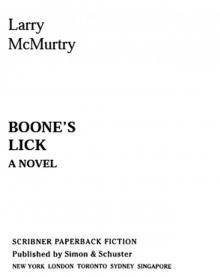 Boone's Lick
Boone's Lick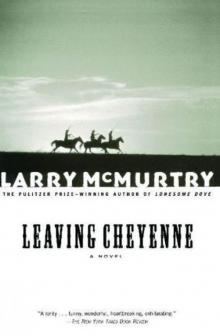 Leaving Cheyenne
Leaving Cheyenne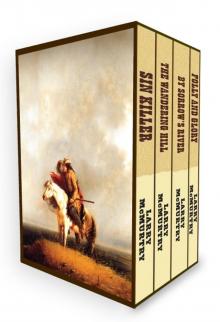 Sin Killer
Sin Killer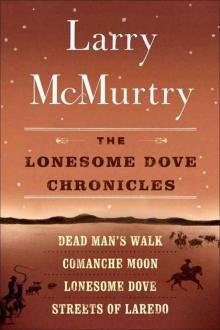 The Lonesome Dove Chronicles (1-4)
The Lonesome Dove Chronicles (1-4)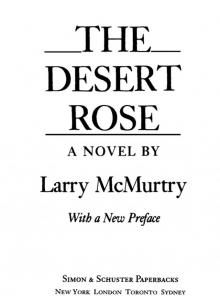 The Desert Rose
The Desert Rose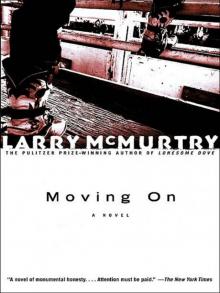 Moving On
Moving On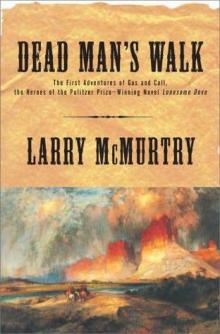 Dead Man's Walk
Dead Man's Walk The Last Picture Show
The Last Picture Show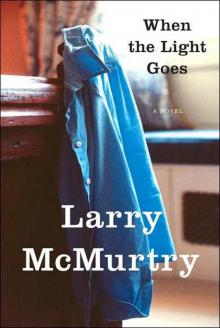 When the Light Goes
When the Light Goes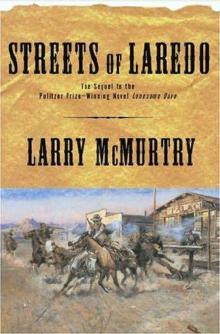 Streets Of Laredo ld-2
Streets Of Laredo ld-2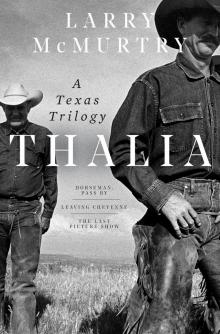 Thalia
Thalia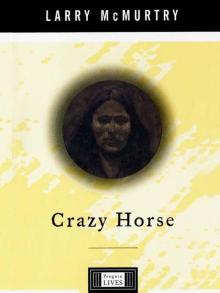 Crazy Horse
Crazy Horse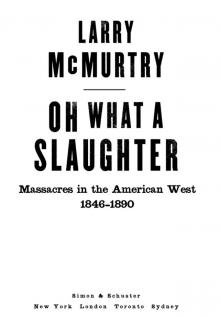 Oh What a Slaughter
Oh What a Slaughter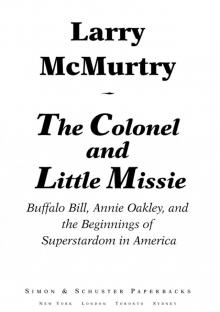 The Colonel and Little Missie
The Colonel and Little Missie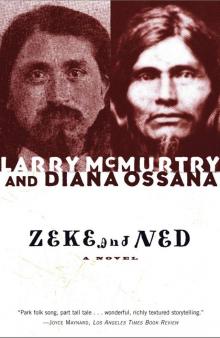 Zeke and Ned
Zeke and Ned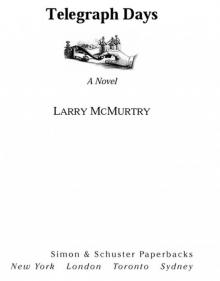 Telegraph Days: A Novel
Telegraph Days: A Novel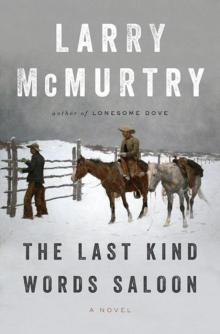 The Last Kind Words Saloon: A Novel
The Last Kind Words Saloon: A Novel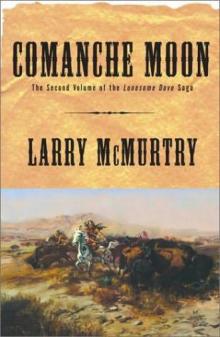 Comanche Moon ld-4
Comanche Moon ld-4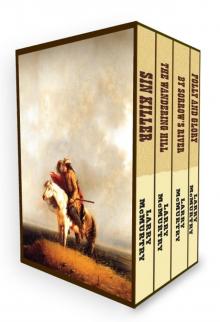 The Berrybender Narratives
The Berrybender Narratives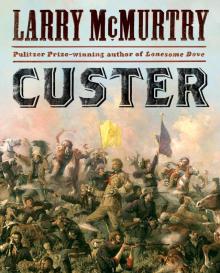 Custer
Custer